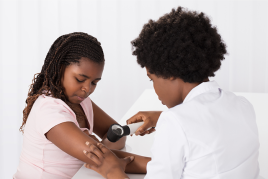Skin cancer types: Sebaceous carcinoma diagnosis & treatment
How do dermatologists diagnose sebaceous carcinoma?
If your dermatologist suspects that you have sebaceous carcinoma (SC), your dermatologist needs some essential information. Be sure to tell your dermatologist if you have:
Muir-Torre syndrome (or if a family member has it).
A transplant organ.
Received radiation treatments, especially to your head or neck.
Taken a diuretic medicine (often used to treat high blood pressure and heart disease).
During the office visit, your dermatologist will:
Give you a thorough skin exam.
Feel your lymph nodes.
Your dermatologist may also perform a skin biopsy. A skin biopsy is the only way to diagnose skin cancer. Your dermatologist can safely do this during an office visit. To perform a skin biopsy, your dermatologist will remove either the entire growth or part of it.
What your dermatologist removes will be examined under a microscope. This magnified view allows a doctor to look for cancer cells.
If SC is suspected, you also will need:
A thorough physical exam.
A through eye exam.
Other medical tests.
Diagnosing SC can take time. The diagnosis is often based on many factors, including:
Your medical history.
The biopsy findings.
Discussions that a dermatologist has with the dermatopathologist (doctor who looks at the tumor under the microscope) and ophthalmologist (eye doctor).
How do doctors know if the cancer has spread?
Before creating a treatment plan for SC, your dermatologist or ophthalmologist wants to answer these questions:
Has the cancer spread to the lymph nodes?
Has the cancer spread to other parts of the body?
To find out whether the cancer has spread, you may need more medical tests, such as:
Fine needle aspiration biopsy: This test is used to obtain a sample from an internal organ, lymph node, or tissue beneath the skin. To perform this test, a surgeon (or other specially trained doctor) inserts a small, hollow needle. Once in the right place, the doctor uses the needle to remove a small sample. The sample will be checked for cancer cells.
Lymph node biopsy: The results from this procedure can tell doctors if the cancer has spread to a patient’s lymph nodes. During this surgery, one or more lymph node is removed. The removed lymph node(s) is checked for cancer cells.
Other medical tests: Other tests that can check for cancer include a colonoscopy, blood tests, and chest x-ray.
How is sebaceous carcinoma treated?
Most patients diagnosed with SC are treated with surgery. Two types of surgery are used to remove SC:
Excision: During this surgery, the surgeon removes the tumor and some surrounding tissue that looks healthy. This helps to remove cancer that may have traveled to an area that still looks healthy. An area can look healthy if it contains just a few cancer cells.
Mohs surgery: Because many SCs develop on an eyelid or other area with little extra skin, Mohs (pronounced "moes") surgery may be recommended. This specialized surgery is only used to treat skin cancer. This surgery allows the Mohs surgeon to remove less tissue yet remove the entire tumor.
During Mohs surgery, the Mohs surgeon cuts out the tumor plus a very small amount of healthy looking tissue surrounding the tumor. While the patient waits, the Mohs surgeon uses a microscope to look at what was removed. The surgeon is looking for cancer cells.
If the Mohs surgeon finds cancer cells at the edge of the removed tissue, the surgeon will remove another small amount of tissue and look at it under the microscope. This process continues until the surgeon no longer sees cancer cells along the edge of the removed tissue. Your Mohs surgeon may refer to this edge as the “margin.” When the Mohs surgeon no longer sees cancer cells along the edges, the surgeon may tell you that the “margins look clear.”
After the cancer surgery, some patients need reconstructive surgery. This surgery is often performed immediately after the cancer surgery.
Findings from a Mohs research study: One study followed 18 patients who had SC on an eyelid. All patients had Mohs surgery. Most (16 out of 18) patients were cancer-free after an average follow-up of 37 months.
Surgery to remove lymph nodes: When the cancer spreads to the lymph nodes, the patient may have surgery to remove the affected lymph nodes. Reports of patients surviving for many years after such surgery have been made.
Radiation treatments: Radiation is not the first choice for treating SC. This treatment may be an option for:
Easing a patient’s pain if the cancer has spread.
Treating patients who refuse or cannot withstand surgery.
Treating patients who have had surgery but may still have some cancer.
Cryotherapy: This treatment involves removing diseased skin by freezing it. More research is needed to find out whether this can be an effective treatment for SC.
Clinical trial: Some patients are encouraged to join a clinical trial. A clinical trial is a type of research study. The purpose of a clinical trial is to study how well a new treatment or a new way of treating a disease works. For some patients, joining a clinical trial may be the best treatment option.
What outcome (prognosis) can a patient with sebaceous carcinoma expect?
When found early and treated, the prognosis is good. It is important to keep in mind that SC is an aggressive cancer. This cancer can return after treatment. For these reasons, it is essential to keep all follow-up appointments with your doctors.
When found early and treated, SC has a high survival rate. The best way to find this cancer early is to return for check-ups. Your dermatologist will tell you how often you should return for check-ups. It is essential to keep all appointments.
References
Nelson BR, Hamlet KR, Gillard M et al. “Sebaceous carcinoma.” J Am Acad Dermatol 1995; 33: 1-15; quiz 6-8.
Spencer JM, Nossa R, Tse DT et al.“Sebaceous carcinoma of the eyelid treated with Mohs micrographic surgery.” J Am Acad Dermatol 2001;44:1004-9.
Torres JS, Amorim AC, Hercules FM et al. “Giant extraocular sebaceous carcinoma: case report and a brief review of a literature.” Dermatol Online J. 2012 Nov 15;18(11):7.
 Molluscum contagiosum: How to safely treat it
Molluscum contagiosum: How to safely treat it
 Biosimilars: 14 FAQs
Biosimilars: 14 FAQs
 Practice Safe Sun
Practice Safe Sun
 Relieve uncontrollably itchy skin
Relieve uncontrollably itchy skin
 Fade dark spots
Fade dark spots
 Untreatable razor bumps or acne?
Untreatable razor bumps or acne?
 Laser hair removal
Laser hair removal
 Scar treatment
Scar treatment
 Botox
Botox
 Free materials to help raise skin cancer awareness
Free materials to help raise skin cancer awareness
 Dermatologist-approved lesson plans, activities you can use
Dermatologist-approved lesson plans, activities you can use
 Find a Dermatologist
Find a Dermatologist
 What is a dermatologist?
What is a dermatologist?